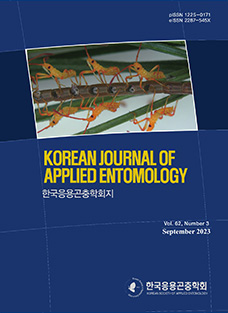The subfamily Xylocopinae consists of four tribes: Manueliini, Xylocopini, Allodapini, and Ceratinini (Cronin, 2004). The small carpenter bees are comprised of the single genus Ceratina of the tribe Ceratinini (Rehan, 2020). The genus Ceratina is comprised of over 200 species worldwide (Rehan, 2020), which are divided into 23 subgenera (Michener, 2007). According to the National List of Korea (NIBR, 2023), four species of Ceratina have been recorded in South Korea: C. satoiYasumatsu, 1936;C. flavipes Smith, 1879; C. japonica Cockerell, 1911; and C. jejuensis Lee, 2005. In this study, C. iwataiYasumatsu, 1936 is reported for the first time from South Korea
Materials and Methods
Materials of the halictid were collected by sweeping. The species studied are deposited in Kunsan National University (KSNU). The terminology used for morphological characters follows Michener (2007). For observation and photography, LEICA DMC2900 digital camera and LEICA M205 C microscope (Leica Geosystems AG) were used. Images were stacked by using Helicon software (Helicon Soft).
Systematic Accounts
Family Apidae Latreille, 1802
Subfamily Xylocopinae, 1802
Genus CeratinaLatreille, 1802
CeratinaLatreille, 1802: 380
ClaviceraLatreille, 1802: 121-122, Synonymized by Daly and Richards, 1970
Subgenus CeratinaLatreille, 1802
Type-species : Hylaeus albilabris Fabricius, 1793=Apis cucurbitina Rossi, 1792
Ceratina iwatai, Yasumatsu, 1936 (Fig. 1A-J)
Ceratina (Zaodontomerus) iwatai, Yasumatsu, 1936: 15(4): 550-552
Ceratina (Ceratina) iwatai, Yasumatsu and Hirashina, 1969: 37(1): 61-70
Description
Morphology. Female Body. Length of total body 4.8mm, length of forewing 3.5mm, width of forewing 1.0mm (Fig. 1A, 1H). Head. Head width 1.1 times as long as height in dorsal view, antennal socket in depression, antenna with 9 segments, dark 1-3 segmented and brown 4-9 segment, covered with short setae densely (Fig. 1D). width of clypeus 1.2 times as long as height in anterior view, supraclypeal area and clypeus flat at same level (Fig. 1B, H), clypeus yellowish, dark at middle, stick out from paraocular area, labrum dark, but yellowish at middle, punctured, Length of eye 1.1 times as long as width in lateral view, punctured near paraocular carina (Fig. 1B). Frons closely and deeply punctured, disconnected in the middle of frontal line, rare setae near frontal line (Fig. 1C). Mesosoma. Scutum glabrous, punctured with whitish setae at side, sparsely punctured at middle, scutellum punctured, concentrated at forward part, parapsidal line present, tegula brownish with whitish setae, forward part of propodeum, propodeal pit present., length of mesosoma 0.7 times as long as length of metasoma (Fig. 1F). Hind leg. Femur and tibia with yellowish setae, densely at tibia, a spur developed at femur, length of hind leg fumer 0.8 times as long as length of hind leg tibia, tibial spurs developed (Fig. 1J). Wing. Forewing: Texture is hyaline and translucent, finely and uniformly setae, prestigma present, length of stigma 0.2 times as long as length of forewing, radius hardened and dark brown, marginal cell and submarginal cell completely present (Fig. 1E). Hindwing: hamuli 11 in numbers. cu-v vein absent, M vein incompletely present (Fig. 1E). Metasoma. Terga 1-6 segment with whitish setae, terga 5 and 6 more densely than that 1 and 2. rough and punctured (Fig. 1G). brownish band in lower part of terga 2-5 and sterna 2-5 (Fig. 1I).
Diagnosis.C. iwatai and C. satoi are very closely allied to each other. Identification of the females is hardly possible unless they were taken together with their own males (Yasumatsu and Hirashima, 1969). In both sex, humeral tubercles of C. satoi are entirely yellowish-white, whereas C. iwatai humeral tubercles are often all black. In C. satoi, the angle on the underside of the hind femur is less conspicuous in males compared to C. iwatai (Yasumatsu, 1936).
Distribution. South Korea (new record), Japan (Sakagami and Maeta, 1977;Azuma et al., 2005), China (Wu et al., 2018)
Specimens examined. South Korea, 3♀, Jeoji-ri, Hangyeong- myeon, Jeju Island (N 33°19'41.9", E 126°16'14.2"), 11. Ⅴ. 2005, Heungsik Lee;
Key to subgenera, species of Ceratina (Yasumatsu and Hirashima, 1969)
-
1. Maxillary palpi 5-segmented; frons just before mid ocellus with an elevated flat disc which is well punctate; 7th tergum of male strongly extending posteriorly into a long projection which is, in most species including Japanese species, bispinose at apex; graduli, for Japanese species, present on 1st to 5th terga and 1st to 4th sterna in female, 1st to 6th terga and sterna respectively (although weak on 6th sternum) in male; 2nd sternum of male usually with a small conical projection in middle ·········· ······································ Subgenus Neoceratina Perkins
-
- Maxillary palpi 6-segmented for Japanese species; graduli, in female, present on 1st to 5th terga and sterna respectively; other characters also not as above ························ 2
-
2. Black with rich yellow markings; metasoma with yellow targal bands; gonostyli of male genitalia with a tuft of long hairs ···························· Subgenus Ceratinidia Cockerell
-
- Black with a few yellow markings; metasoma always entirely black; gonostyli of male genitalia with sparse hairs not forming a tuft or comb ····································· ······························ Subgenus Ceratina sensu stricto... 3
-
3. Tubercles often all black in Japanese specimens; ventral spine on hind femora of male robust, subtriangular; 5th sternum of male with apical margin gently emarginate in middle ·············································· iwatai Yasumatsu
-
- Tubercles with whitish markings at least at apices; ventral spine on hind femora of male slender, needle-like; 5th sternum of male with apical margin triangularly emarginate in middle ················································· satoi Yasumatsu









 KSAE
KSAE





